|
Argentine History &
Modelling
IAI Dagger C-430
by Pablo Calcaterra
|
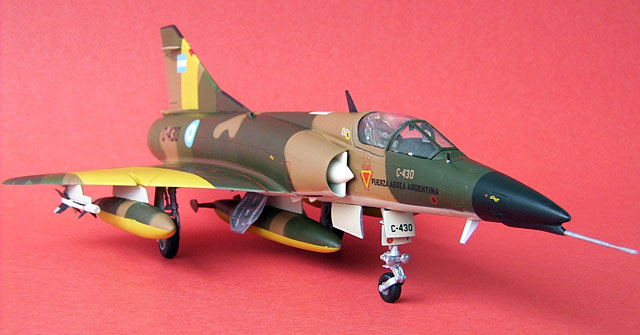 |
|
Argentine IAI Dagger
C-430 |

Trumpeter's 1/32 TBF Avenger is available online from Squadron.com
The Plane:
As it is well known, the IAI Dagger was the Israeli
built Nesher, a copy of the Mirage 5 that took part in the 1973 war.
Neshers were credited with ¼ of all the air-to-air claims of the Israeli
Air Force.
Being an unauthorized copy of the Mirage and due to
the specs of the Israelis, this plane was quite basic, lacking a radar
and modern direction finding instruments. Nevertheless, it is supersonic
(Mach 2.2) and has 7 external stations for armament and fuel. For
air-to-air combat it has 2x30 mm cannons and can carry 2 Shafrir
missiles, quite modern during the early 70’s built out of date in the
80’s, requiring to be fired within a 20 degree cone behind the foe…the
Sidewinder that equipped the Harriers could even be fired head on!
C-430 was received in the second batch of planes in
1981 and had flown by that time 607:25 hours. It was allocated to VI
Brigada Aerea in Tandil, Buenos Aires Province.
The War:
The Malvinas/Falklands war (2 Apr - 14 Jun 1982),
the last colonial war of the XX century, is called by many as a minor
one. Nevertheless, the ground actions lasted more days than the Gulf
Wars, the British Task Force was the largest assembled since WWII, the
consumption of ammunition per day was bigger than in Korea, the Royal
Navy and auxiliaries ships suffered the worst casualties since WWII (7
ships sunk, 5 out of action and at least 12 more with different degrees
of damage), the British infantry suffered more casualties per day than
in Korea and any other post WWII conflict, some Brigades of the
Argentine Air Force lost at least 30% of their planes and pilots, the
Argentine guns run out of ammo, and the list can go on…It was the first
and only war fought by the Argentine Armed Forces against another nation
in the 1900s, and as such, it was the debut of the Air Force.
On April 7th, C-430 arrived to his
permanent base during most of the conflict, Rio Gallegos in Tierra del
Fuego.
On the 29th, all planes received yellow
ID bands on the tail and above and below the wings. Though they were
supposed to be of width of 1 meter, it can be seen in the pictures of
the war that the position and size varies from plane to plane. C-430 is
particular because it was one of the few that had a vertical tail band
and the wings ones were wider than the standard.
The Missions:
May 1st saw the first combats of the
FAA (Fuerza Aerea Argentina). C-430 was part of the I Escuadron
Aeromovil “Las Avutardas Salvajes”.
OF 1091:
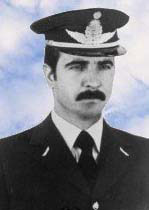 Launched
after the first air raids of the RAF and Task Force on the islands.
C-437 was flown by Capt. Carlos Moreno and C-430 by Lt. Hector
Volponi. Their code name was TORO. Their task was to intercept the
British raiders. They took off while it was still dark with 3 fuel
tanks and 2 Shafrirs. When they arrived to the Islands they were
informed by the CIC in Puerto Argentino (Port Stanley) that there
were 2 bandits 120 miles away. The Daggers accelerated with Volponi
500 mts. on the left of Moreno and 10 degrees behind. When they were
30 miles away from the Harriers flown by LtCdr RN Robin Kent and Lt
Brian Haigh of HMS Invincible and aware of the better air-to-air
capabilities of the Harrier, Moreno asked the CIC to help them to be
positioned on the side of the British CAP during the crossing. When
the 4 planes were 9 miles away and 1 mile to one side, Moreno
ordered to drop the 2 tanks under the wings, keeping the one in the
center, which still had some fuel remaining. TORO 1 asked the
controller to remind them to check the fuel status during the combat
as the range of the Daggers was on the limit. When the radar told
the TOROs that they were crossing the Harriers, the Daggers turned
steeply towards the right with afterburner, trying to get on the
tail of the 4000 feet lower flying SHARs. The 4 planes started to
turn in a circle without seeing each other’s and when the Argentine
planes were behind the British ones, these abruptly changed the
direction and got behind the first ones due to their great
maneuverability. CIC Puerto Argentino was periodically asking the
pilots about the fuel status. Volponi in C-430 asked Moreno if he
had fired a missile, as he had just seen one flying between them. It
had been a Sidewinder that missed them (British reports claim that
they did not fire a missile during this engagement). Launched
after the first air raids of the RAF and Task Force on the islands.
C-437 was flown by Capt. Carlos Moreno and C-430 by Lt. Hector
Volponi. Their code name was TORO. Their task was to intercept the
British raiders. They took off while it was still dark with 3 fuel
tanks and 2 Shafrirs. When they arrived to the Islands they were
informed by the CIC in Puerto Argentino (Port Stanley) that there
were 2 bandits 120 miles away. The Daggers accelerated with Volponi
500 mts. on the left of Moreno and 10 degrees behind. When they were
30 miles away from the Harriers flown by LtCdr RN Robin Kent and Lt
Brian Haigh of HMS Invincible and aware of the better air-to-air
capabilities of the Harrier, Moreno asked the CIC to help them to be
positioned on the side of the British CAP during the crossing. When
the 4 planes were 9 miles away and 1 mile to one side, Moreno
ordered to drop the 2 tanks under the wings, keeping the one in the
center, which still had some fuel remaining. TORO 1 asked the
controller to remind them to check the fuel status during the combat
as the range of the Daggers was on the limit. When the radar told
the TOROs that they were crossing the Harriers, the Daggers turned
steeply towards the right with afterburner, trying to get on the
tail of the 4000 feet lower flying SHARs. The 4 planes started to
turn in a circle without seeing each other’s and when the Argentine
planes were behind the British ones, these abruptly changed the
direction and got behind the first ones due to their great
maneuverability. CIC Puerto Argentino was periodically asking the
pilots about the fuel status. Volponi in C-430 asked Moreno if he
had fired a missile, as he had just seen one flying between them. It
had been a Sidewinder that missed them (British reports claim that
they did not fire a missile during this engagement).
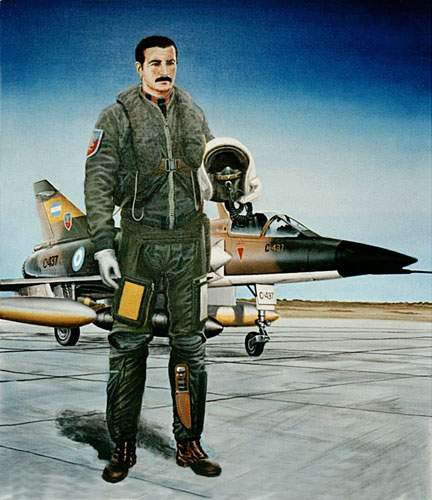
After approximately 2 minutes of maneuvers, the
Argentine planes were forced to break the combat as their fuel was
only enough to reach the continent. At that moment, the SHARs also
broke to return to their carrier. The return to their base was
uneventful and thus finished the first ever air-to-air mission of
the FAA.
OF 1100:
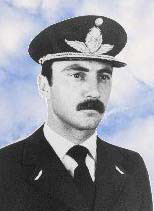 Flown
by Capt. Mir Gonzalez in C-430 and Lt. Bernhardt in C-437. Both
planes were configured like in the previously mentioned OF and their
code was CICLON. They took off at 12.30hs and when they arrived over
the Islands were ordered to remain circling waiting for some trade,
keeping 28000 feet. Moments later they were told that there were 4
bandits 70 kilometers to the North and slightly below them (British
accounts say it was only a pair of planes). Mir Gonzalez accelerated
trying to reach the Harriers and when they were 40 kilometers behind
the British CAP, CIC Puerto Argentino informed them that these ones
had turned facing them. CICLON 1 ordered his wingman to drop their
external fuel tanks and seconds later the Argentine pilots were
informed that the 6 planes were in the same spot. Suddenly Bernhardt
saw one of the Daggers spiraling down and informed his leader.
Without thinking it twice, he dived in pursuit. Mir Gonzales was
about to warn his wing man that another Harrier could now slip
behind his tail when CICLON 2 started to climb again, his pilot
realizing that this could be a trap (as it had been described by the
Spanish pilots to the Argentine ones during some letters of advice
that sent before May 1st). The Harrier had disappeared
under some low clouds. The Daggers closed their formation again and
started to wave trying to find the other 3 remaining SHARs. After 4
minutes of search, they were forced to return to the continent due
to their low fuel. At the same moment, the British planes also
turned to return to their base. Another inconclusive engagement. Flown
by Capt. Mir Gonzalez in C-430 and Lt. Bernhardt in C-437. Both
planes were configured like in the previously mentioned OF and their
code was CICLON. They took off at 12.30hs and when they arrived over
the Islands were ordered to remain circling waiting for some trade,
keeping 28000 feet. Moments later they were told that there were 4
bandits 70 kilometers to the North and slightly below them (British
accounts say it was only a pair of planes). Mir Gonzalez accelerated
trying to reach the Harriers and when they were 40 kilometers behind
the British CAP, CIC Puerto Argentino informed them that these ones
had turned facing them. CICLON 1 ordered his wingman to drop their
external fuel tanks and seconds later the Argentine pilots were
informed that the 6 planes were in the same spot. Suddenly Bernhardt
saw one of the Daggers spiraling down and informed his leader.
Without thinking it twice, he dived in pursuit. Mir Gonzales was
about to warn his wing man that another Harrier could now slip
behind his tail when CICLON 2 started to climb again, his pilot
realizing that this could be a trap (as it had been described by the
Spanish pilots to the Argentine ones during some letters of advice
that sent before May 1st). The Harrier had disappeared
under some low clouds. The Daggers closed their formation again and
started to wave trying to find the other 3 remaining SHARs. After 4
minutes of search, they were forced to return to the continent due
to their low fuel. At the same moment, the British planes also
turned to return to their base. Another inconclusive engagement.
OF????:
On May 8th, a mission to lure the
Harriers into combat was planned. AGUILA section was C-430 was flown
by Capt. Cimatti and C-437 flown by Capt. Robles. Once they arrived
to the Islands flying at 27000 ft, the CIC sent them against a
British CAP. When they were 40 km away, the Harriers turned away and
the Daggers, short of fuel, started to fly back to Rio Grande. Half
way to the continent, C-437 had a problem with the engine and it
started to loose height. Cimatti circled the descending Robles to
give him protection when after some moments and after being ordered
to return to the islands to eject, the engine started to work
properly again. When they were less than 200 km away from firm
ground, C-430 started to have problems with the transfer of fuel
from the auxiliary tanks to the main ones, so Cimatti had to drop
them. And when they found that their base was covered in low clouds,
C-437’s artificial horizon quit so Robles stuck to Cimatti’s planes
that led him to a safe landing, with minimal fuel remaining.
Interlude:
May 23rd saw the transfer of C-430
and C-411 from the I Escuadron to the II Escuadron to compensate the
losses this one had suffered. II Escuadron was called “La Marinete”
and was based in San Julian, Santa Cruz Province. Capt. Demierre
flew the plane in this occasion.
During the early hours of the 24th
the maintenance crews had to travel to the town to get green paint
to cover the ineffective yellow bands with green paint. The only one
they found available was light blue. They found that the surface of
the planes was covered in frozen mist, so they had to remove the ice
first with newspaper and then apply the coats of paint. This process
gave origin to the well-known turquoise color of the A-4Cs and the
Daggers of “La Marinete”. It can be seen in the picture, taken
shortly before C-430’s last mission, that there is some yellow
showing through.
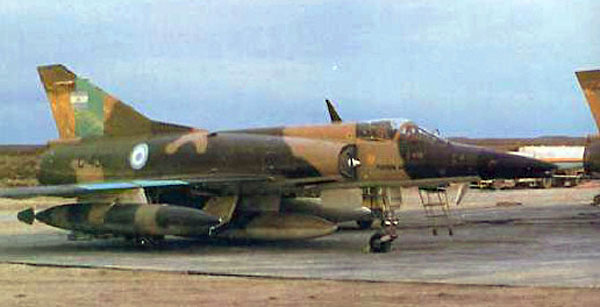
OF 1228:
 With
the British troops firmly in control of San Carlos, missions against
them and the ships in the area were planned. This OF targeted the
last ones. The leader of ORO section was Capt. Diaz in C-430, with
Maj. Puga in C-410 and Lt. Castillo in C-419 as his wingmen. All
planes were armed with 2 x 250 kg BRP bombs. They took off at 10.20
hs and where flying North of Isla Borbon (Pebble Island), at aprox
500 kt and 15 mt above the waves on their way to the target, when a
British CAP intercepted them, vectored by HMS Broadsword. Diaz was
in the center, with Castillo to his left and Puga on his right, each
200 mt away from his leader. Andy Auld and Dave Smith approached the
Daggers from behind. With
the British troops firmly in control of San Carlos, missions against
them and the ships in the area were planned. This OF targeted the
last ones. The leader of ORO section was Capt. Diaz in C-430, with
Maj. Puga in C-410 and Lt. Castillo in C-419 as his wingmen. All
planes were armed with 2 x 250 kg BRP bombs. They took off at 10.20
hs and where flying North of Isla Borbon (Pebble Island), at aprox
500 kt and 15 mt above the waves on their way to the target, when a
British CAP intercepted them, vectored by HMS Broadsword. Diaz was
in the center, with Castillo to his left and Puga on his right, each
200 mt away from his leader. Andy Auld and Dave Smith approached the
Daggers from behind.
Auld fired his missiles first. Puga saw
Castillo’s plane explode and warned Diaz by saying: “# 3 has been
shot down by a missile” but Diaz thought he was talking about one of
the preceding sections. Then Puga repeated it but added: “ORO 3 has
been shot down by a missile”. When Diaz turned his head toto see
Puga, he saw a zigzagging light 200 mts. behind C-410. He only had
time to shout to his remaining wingman to eject, but at that same
moment the second Sidewinder of Auld hit Puga’s plane. Only the
cockpit and nose were outside the ball of fire and smoke. Unaware
that he was being chased, Diaz ejected his external ordnance and
while insisting his order to Puga that he had to bail out, turned
tightly towards the South (his right) to take a closer look. By
then, Smith had fired one of his missiles to Diaz.
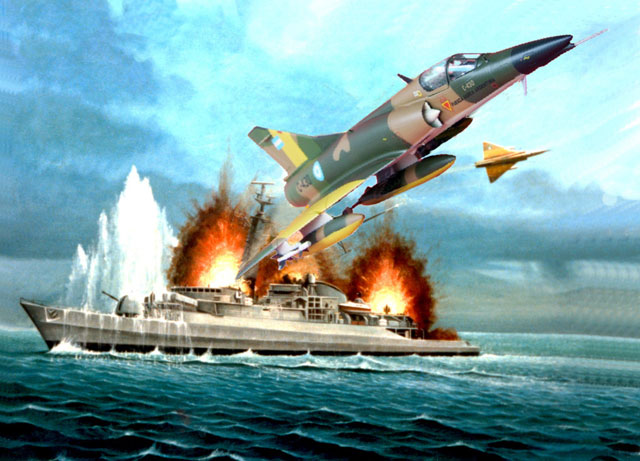
Half way into his turn, the Argentine pilot
felt a great shake and immediately all the alarms lights went on, as
did the acoustic one meaning that there was a terminal failure. He
immediately understood that C-430 was doomed and that he had to
eject. He passed close to Puga’s still flying and burning plane and
then C-430 started to climb and dive without control. As Diaz could
not reach the top ejection handles, he pulled the one between his
legs. The hit of the air made him believe that he had crashed with
the plane into the water or the land but he realized he had ejected
successfully when he saw his knees against the sky. The next moment,
the parachute opened and looking down he saw the ground getting
close 80 mt below him. Before landing he knew he was injured because
of the pain he was feeling. He touched ground 600 mt inside the
shore in great pain. At first he thought he had lost the arm as he
could not feel and see it. Carefully he pulled the jacket’s right
arm from below his body with his left hand, and found that his right
one was still in place. Had he fallen in the water, he would had
drowned as he had his right arm out of the socket and two broken
vertebrae, product of the ejection above the 450 kt guaranteed by
the seat manufacturer. C-430 was destroyed when it impacted the
ground

As he was close to suffer a shock, Diaz drank
all the water from his survival kit. After 90 minutes of gathering
strength and all the indispensable items to try to walk to any house
he could find, he saw a Land Rover approaching. Painfully he took
his gun to fight in case they were British troops. The two men that
descended from the vehicle were whispering and pointing at him. When
they saw the bad shape Diaz was in, they asked his name in perfect
Spanish. Relieved to have been found by Argentine troops, he dropped
his gun. They were pilots of the Argentine Navy, whose T-34 had been
destroyed by the raid of the SAS on the 15th. Diaz was
taken to a kelper settlement and he received first aid. As nobody
had seen Castillo or Puga ejecting, he thought they both had been
killed and was very sad.
In fact, Puga flew for some seconds more and he
noticed one of his wings catching fire. Immediately this wing broke
off and the plane rolled in that direction. With the plane turned on
one side, he was able to bale out PARALELL to the sea at such a low
height that his seat bounced in the water like a stone. This saved
Puga’s life as it cushioned the fall when he hit the water as his
parachute was partially deployed and he was still tied to his seat.
Finally he was able to break free of seat and parachute lines and
swam 6 hours towards the shore. He was not injured and was saved by
the anti exposition suit he had helped to test during the first days
of April (these suits were issued for the first time ever to the Air
Force pilots after the tests Puga took part in). He spent the night
on some rocks on the seaside, exhausted. On the 25th,
Puga was found safe and sound and was taken to the place where Diaz
was being treated. From this place, they were able to see the smoke
and flames of the sinking Coventry on the 25th.
Due to the serious injuries that Diaz had, a
rescue mission was planned for the 28th. Finally carried
out on the 29th, it meant that a FAA Twin Otter would
land in the poor runway of Borbon Island, pick up the pilots and
return to the continent. While they were landed, there was a red
alert. To retransmit the orders and tactical situation it was used a
F-27. Now, at 18.00 and with the dark runway light with only 4
precarious lights, they took off also taking with them 4 Navy
personnel and the rests of Volponi, shot down on the 23rd.
They flew skimming the waves and landed back in Puerto Deseado at
20.30 hs.
Fates of these Argentine pilots
Volponi:
Flew some more missions before being finally
shot down and killed in C-437 by a Sidewinder fired by the Harrier
ZA194 flown by Lt. Martin Hale on May 23rd, North of Bahia Elefante
(Isla Borbon/Pebble Island). He was returning to his base after a
failed attack on the Task Force in San Carlos, his leader being able
to outrun the Harriers and return to their base.
Moreno:
Survived the war. He flew numerous missions
during the war, the most important when he was the leader of one of
the two Dagger sections that attacked and left out of combat HMS
Antrim.
Mir Gonzalez:
Survived the war. The most effective missions
he flew were when he led the flight of Daggers that seriously
damaged HMS Ardent on May 21st (sunk in conjunction with
the Skyhawks of the Argentine Navy and Grupo 5) and on the 24th
the AZUL attacked RFA Sir Bedivere. His wingman on the 29th
was shot down and killed. He was…
Bernhardt:
He took part in the missions against Ardent
(his bomb exploded and destroyed the hangar of the ship) and Sir
Bedivere. He was the only confirmed kill of the Rapier system in the
war (C-436).
Cimatti:
Survived the war. Escorted on May 4th
the Super Etendards that sunk HMS Sheffield and took part in the
mission that severely damaged HMS Plymouth on June 8th.
Robles:
Survived the war. Also escorted the SUEs on May
4th and took part in the attack on Sir Bedivere.
Diaz:
Survived the war. Led the first attack on HMS
Brilliant on May 21st.
Puga:
Survived the war.
Castillo:
As it was mentioned above, was killed on the 24th.
Was a member of the other section that disabled HMS Antrim on May 21st
Demierre:
Survived the war. He had only logged 45 hs in
Daggers and took part in a couple of attacks on ground targets.
I used the old Esci 1/48th kit that I
had traded with my friend Fernando Benedetto. This is the old Mirage III
so there is a lot of work to do to transform it into a Dagger. The lines
are not recessed but I don’t care about it because I consider that it is
too much difficult work. I chose to build C-430 because it took part in
the first ever air to air combat of the FAA, it was one of the only ones
armed with missiles during the conflict and had the vertical tail band.
Fuselage:
First I used the resin seat by Aires for French
planes. To make it fit in the cockpit I had to sand the base a couple
of millimeters PIC 1. I used the decals of the kit for the cockpit, but
as they were old they broke in several pieces and I was force to
reconstruct them. I also cut out the nose to replace it and assembled
the fuselage halves along the cockpit. I had to putty and sand the union
of the halves.
The nose is the Dagger one made by RD Producciones
(Ricardo Dacoba)
Using the part of the Italieri kit, I copied in
resin the extension of the dorsal fin. I also had to scratch built the
base of the antennas on either side of the tail (more about this
later…). The little sensor ahead of these bases was also scratch built.
The weight of the resin nose is enough to avoid a
tail sitting plane. I had to use some acrylic base (white in the
picture) to improve the union of the nose and the fuselage.
Click on the thumbnails
below to view larger images:
The missile pylons came from the Italieri kit (you
can see the different gray color of the plastic). The ones for the
external fuel tanks were copied from the Italieri one, but as they come
in one piece attached to the tanks, and to make my work easier, I cut
them out from the original kit, thus having 3 pieces to make the tanks,
instead of the 2 originals of Italieri. As you can see, I had to fix
some holes in my resin parts. It took me a lot of work to remove the
joint marks of the upper and lower halves of the wings, which are very
prominent close to the underside of the leading edge.
More acrylic base was used to improve the joint of
the upper side of the wings and fuselage. This product is very good
because it dries solid and you don’t need to use sandpaper.
I added the supports of the air intakes. This I
scratch built using some laminated plastic I have. The internal side was
painted in white.
Finally I could start checking with paint the
quality of my work along the unions and gave the underside the hand of
very light gray FS 36622 (Modelmaster). The lid of the compartment
behind the cockpit was painted in this color too and then masked.
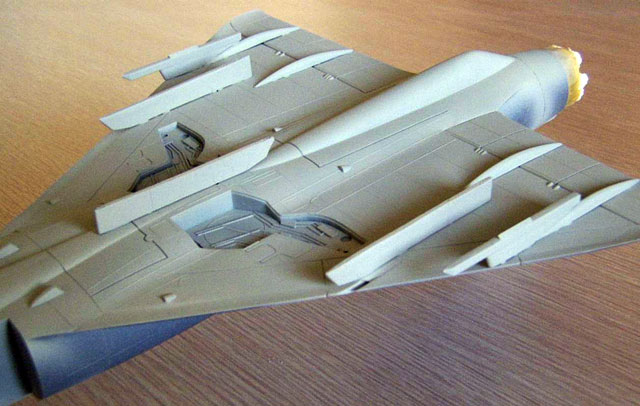
Click on the thumbnails
below to view larger images:
External fuel tanks:
Also copied from the Italeri kit, as Esci only
supplies the 500 lt version (I needed the 1300 lt ones). It was a
difficult task to made the resin replicas, and finished with lots of
excess, which I sanded with a lot of work. It took me 2 whole nights of
3 hours to sand, glue, putty and sand again each tank (6 nights in
all!!)

Missiles:
The Esci ones are similar but too long to make an
acceptable Shafrir. I had to short them aprox 1 cm close to the main
fins. Diameter of the body and size of the fins is fine. I painted the
fins in black and then carefully removed the triangular ones, as I
wanted to glue them in the natural position when the plane is on the
ground.
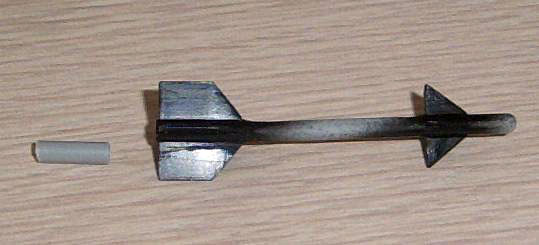
Later on I masked the black main fins, leaving the
tips for the dark gray paint and the body for the white one. I removed
the tip of the nose and replaced it with carefully sanded transparent
plastic from some spruce of the spares box.
Painting
After masking the undersides, pylons, cockpit and
exhaust, I gave the plain the first coat of nice color: TAN Humbrol
118.
As I am getting bad with time, and not better, with
the free hand technique, I was forced to use for the first time the more
(apparently) time consuming paper one: check the picture, cut a piece of
paper with the shape and size of the brown cammo, stick it with masking
tape on top of the paint to protect. I say apparently because, if it is
well done, this technique saves a lot of anger, time and retouching. It
was repeated for the light green (Humbrol 117) and finally I applied the
dark green (Humbrol 116).
Then I masked the areas around the yellow ID bands
and used Humbrol 24. The tail band was too wide (see that it goes over
the front part of the base of the antenna, which is wrong) so I had to
mask the yellow band and redo all the work with the 3 basic cammo
colors!
More careful masking and the edges of the tail fin
were painted in black. Same color was given to the nose. Even though is
black, the Daggers did not have a radar inside the nose. This was only a
disguise.

Click on the thumbnails
below to view larger images:
I glued the scratch built and white painted
antennas on the tail, and removed the masking tape of the compartment
behind the cockpit. Here is when I found that I had place the scratch
built bases 1 mm too low and 2 mm ahead. Too late to fix it…
I glued the legs in place leaving the wheels for
later. The support strut of the nose one is quite tricky and required a
lot of sanding to make it fit properly. Using a pencil, I highlighted
all the pipes in the wheel wells.
The painted main wheels were glued in place. The
area around the guns was painted using a soft black pencil.
Decals
I started by the Shafrirs. I took the red bands
from the 1/72 Dagger kit from Aerocalcas and used the numbers of the
decal sheet to write the serial number of the missiles. Then I used 4
stencils from Esci only: the yellow and black lids on the bottom of the
plane (I tried to strengthen them with a coat of Future and it partially
worked). The rest of the decals are from Aerocalcas. Though sometimes 2
or 3 decals make up 1 stencil, they are thin are adhere very well to the
surface. First I applied the ones to the bottom of the fuselage, and
then moved to the wings, where the long red strips took a lot of
patience. The decals for the air brakes are not right (or the airbrakes
are misshaped…) so I had to cut them in 3 or 4 pieces to shrink them and
fit better. The decals for the red lines are not enough because you need
some more for the triangle that surrounds the air brakes. I used some
from the Mirage III set of Aerocalcas. Then I moved to the stencils of
the fuselage.

Care must be taken (watch carefully the pics of the
plane you want to build) as these varied from plane to plane. The yellow
and red ejection seat warning are too big for the Dagger, but I did not
have any other available at the time so I had to make do…I consider that
the red round inspection decal is also a little bit too big. Then I
moved to the serial numbers close to the end of the fuselage. Here I
found that my tan cammo on the right side was a little bit too small so
I was forced to misplace the serial number some millimeters. It should
start closer to the tail of the plane, with probably the whole “C-4”
outside the wings. The roundels and flag where applied with no problem,
just careful alignment. With this the model was completely “dressed”.
The black areas inside the red circles and inside the emergency ejection
system behind the cockpit were painted in black using a pencil.
Daggers were given a satin finish, so I used
Humbrol varnish. Then I painted the position lights, in aluminum the
cone of the parachute below the tail and the landing lights and the tip
of the probe ahead of the antennas in chrome silver. Drops of future
covered the landing lights and the transparent nose of the Shafrirs.
With gel I positioned the drop tanks. The little
fins of the missiles where placed in a way to represent the position
they have while the plane is on the ground (loose, with the rear part
dropped). Then they were stuck to stations 1 and 7.
The Top ejection seat handles were made with wire
and painted in yellow and black (I discarded the originals from Esci as
the shape is completely wrong).
All the landing gear doors where placed.
The VHF antennas (dorsal in black, ventral half
white and half gray) were glued with instant gel. The little air intake
just ahead of the windshield was scratch built and painted in dark
green.
I glued the gunsight and scratch built the two
instruments dangling from the frame of the windscreen. A couple of
handles of the canopy were scratch built and the rear mirrors were made
cutting to shape some photo etched frames. The back of the mirrors was
painted black once they had been glued to the canopy.
Click on the thumbnails
below to view larger images:
Finally I glued the windshield and placed the
canopy. I found a correct in shape and length nose probe in the spares
box. I painted it in aluminum and with this last part in place my Dagger
was ready.
This article is dedicated to the ones who fought
for their true believes and without hate in their hearts, and specially
to those who did because they were taught when they were little kids 6
or 7 years old that: “Las Malvinas son Argentinas”.
To Exequiel Martinez (his paintings of the history
of the aviation in Argentina, including this war, can be seen in the
buildings of the FAA across the country and were published in several
books. He is a famous helicopter pilot in Argentina, who flew SAR
missions during the war and lent me his panting of Volponi, which is
currently on display at the VI Brigada Aerea. You can visit his website
to admire his paints), Fernando Benedetto, Fabian Vera of Condor Decals,
Hernan Casciani, Alejandro Serra of Aerocalcas and Vicecomodoro Claudio
Marcos (FAA).
Bibliography and Sources:
-
Dios y los Halcones (Pablo M. R.
Carballo)
-
Halcones sobre Malvinas (idem) –
these two books are first hand accounts by the FAA pilots and
personnel that fought in the war
-
Historia Oficial de la Fuerza Aerea,
Volumen 6 (Malvinas), 2 books
-
La Guerra Inaudita (Ruben Moro)
-
Ellos tambien combatieron (Guillermo
Posadas) – in charge of Maintenance of the I Escuadron Aeromovil
during the war
-
Falklands Air war (Hobson) – the most
reliable British source about the air war that I have been able to
find so far, though in 2003 and with lots of Argentine sources to
check, it still has some errors that I want to point out, among
others:
-
The claim that Garcia Cuerva’s
plane had been damaged and thus decided to land in Puerto
Argentino/Stanley on May 1st: he did that in fact
because his plane was low on fuel due to the length of the air
combat and he wanted to save his Mirage III as it was in
pristine condition, as thousands of witnesses in the airport can
confirm,
-
On May 1st, the SHARs
that were in pursuit of one of the Daggers (TORNO) that attacked
the ships in front of Puerto Argentino turned away not because
they were low on fuel but because the escorting FORTIN section
of Daggers (Donadille and Senn) had got too close behind them (3
miles) and were going to get them before the Harriers were able
to catch their intended prey (Roman, TORNO 2)
-
Thomas plane was damaged by the
guns of Donadille or Senn on May 21st, as these two
pilots shot at a Harrier during the short engagement in which
they were downed, and Thomas claim that he had been hit at Port
Howard after the dog fight cannot be true as there were no AAA
weapons there, except Blow Pipe missiles. So the only possible
sources of damage to his plane are the 30 mm shots from one of
the Argentine Daggers.
-
Castillo was the first one to be
shot down, not the last (it was Diaz) during May 24th.
-
Air War in the Falklands 1982 (C.
Chant - Osprey) – several important mistakes when dealing with the
Argentine side of the air war.
-
Guerra Aerea en las Malvinas (Benigno
Andrada)
-
Dagger & Finger en Argentina (Horacio
Claria et al.) – an extremely good book, but the planes profiles
must be checked against pictures of the actual planes
-
La Batalla Aerea de Nuestras Islas
Malvinas (Pio Matassi)
-
Harrier over the Falklands (N. Ward)
– a book full of mistakes and misconceptions to say the least (i.e.:
on the morning of May 25th there had been no attacks from
the FAA during the morning because the pilots were watching soccer
games…fact is that two Skyhawk pilots lost their lives trying to
attack San Carlos during the first part of the day)
Click on the thumbnails
below to view larger images:
Model, Images and Text Copyright ©
2005 by by Pablo
Calcaterra
Page Created 06 October, 2005
Last Updated 09 October, 2005
Back to HyperScale
Main Page
|
Home
| What's New |
Features |
Gallery |
Reviews |
Reference |
Forum |
Search